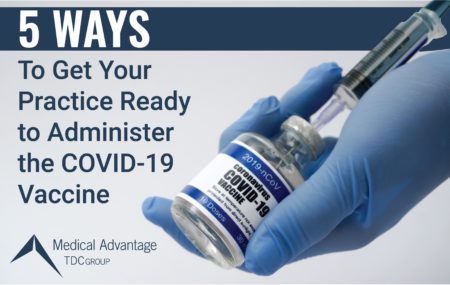As eligibility requirements for the COVID-19 Vaccine continue to ease at state levels – and following the White House’s announcement that every adult in the nation should be made eligible by May 1st – many medical practices nationwide are moving quickly to set up a vaccination administration program at their practice, if they haven’t done so already.
But, as these practices have found, getting a vaccination program off the ground as quickly as possible is not without its problems and challenges. Medical Advantage’s practice consultants have been on the ground setting up vaccination programs in practices nationwide – and have compiled 5 of their top tips for making sure your vaccination campaign goes as smoothly and effectively as possible.
5 Steps to Prepare Your Medical Practice to Administer the COVID-19 Vaccine
1. Understand – and Plan Around – Your Vaccine Supply Chain
Procuring and receiving your organization’s supply of vaccines is the first step to vaccinating patients, and it comes with a host of questions in and of itself. Will your organization be getting its vaccines from a state government, or from a private vendor? Which vaccines will you order? Build your timing and scheduling policies around what your supplier is capable of. Will your supplier be delivering only one or multiple brands of the vaccine? This is important for dosing timelines.
Lastly, while vaccine supply chains are getting stronger and more secure, have a plan in place for a vaccine “surge” – that is, when a batch of vaccines is at risk of going unused at the end of the day – and for how those doses will be used.
2. Consider the Size of Your Vaccination Program – and the Staff, Training, and Locations Needed
Once your supply is secure and stable, it’s time to think about how ambitious you want your program to be. The more patients you want to vaccinate, the more staff you will need – and the more training you will need to perform to get those staff up to speed on vaccination-related workflows, codes, and regulations. In addition, consider if you are going to want to vaccinate at just one or multiple locations, as this will also determine administrative burden. Our team has advised on both in-house and mobile vaccination delivery systems to serve vulnerable populations.
3. Education, EHRs, and More: Put Workflows and Policies in Place
An effective vaccination program starts with the patient population, and that means that educating patients is crucial. Take advantage of the fact that most patients are, at this point, comfortable with getting information through their online portal, the practice’s website, or text and email campaigns – and do everything you can to steer patients to information online, to prevent them from calling with questions and thereby increasing administrative burdens.
Instruct patients to sign up through their online portal to be notified when they are eligible – if your EHR has online connectivity, you may be able to set up questionnaires that prescreen patients, determine their eligibility, and in some cases even ask for information that satisfies individual state requirements for vaccination reporting.
4. Schedule Strategically – Leverage Your EHR
Take advantage of your patient’s physical presence at the first vaccine dose to schedule their second appointment. Many EHRs are capable of automatically running gap reports to determine the date and time needed for a second report – be careful to remember that certain vaccines (like the Moderna vs. Pfizer brands) have different recommended timings between doses.
5. Make Sure to Bill and Code Vaccinations Properly
While other, non-COVID vaccines have their own CPT code for the medication which is usually the same as the code for administration, this is not the case for the COVID vaccine. Each vaccine has one medication CPT code, but there are unique administration codes. Pfizer, Moderna, and AstraZeneca have two codes each – one for the first dose, and one for the second dose – and Janssen (Johnson & Johnson) has a unique code for their single dose.
Additionally, some customization may be needed in the way vaccine immunization inventory is handled by their EHR or, if coding is automated, there may need to be some adjustments made to that configuration. Your practice may also want to consider adding information about proper setup of CVX codes, which are crucial for proper reporting to state immunization registries.
Medical Advantage Can Help
In addition to its extensive solution portfolio spanning EHR optimization, telehealth, practice financial and performance analytics dashboards, billing and coding, RCM, and many other service lines, Medical Advantage’s expert team of consultants have been on the ground for months helping practices thrive during the pandemic. Setting up new office procedures and workflows, enabling practices for telehealth and changes in billing, developing custom reports on COVID-19 cases and helping to establish COVID-19 vaccination programs nationwide. Our consultants understand what does and doesn’t work when setting up a vaccination program – and can help position your organization for success, as more and more Americans become eligible to receive vaccinations. Don’t miss out on this opportunity to provide quality care, increase revenue, and continue the fight against the COVID-19 pandemic – contact one of our healthcare consultants today.





